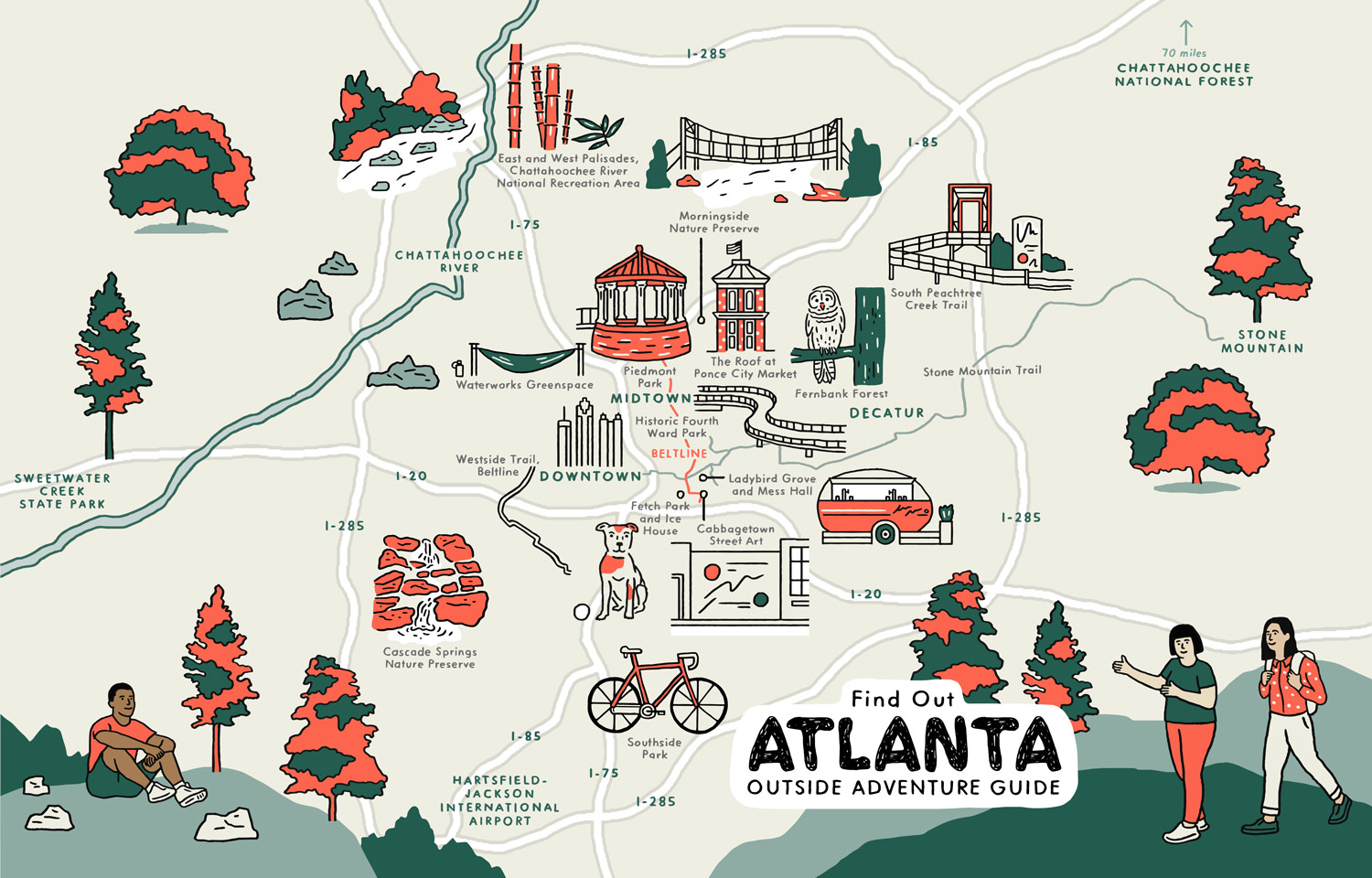
Atlanta Outdoor Activities Guide
Peek out the window as you fly into Atlanta’s Hartsfield-Jackson International Airport, the world’s busiest passenger airfield, and you’ll understand why this Southern metropolis is known as the “City In a Forest.” A lush canopy stretches out from its skyscrapers, shading the bustling city in every direction. But the real action happens beneath the leaves as Atlanta has been busy building out its park system, including the BeltLine, an ongoing rail-trail conversion and one of the most ambitious greenway projects in the country. Though only a handful of sections have been completed, the trail already attracts nearly 2 million visitors a year, and once the project wraps up, hopefully by 2030, more than 30 miles of planned multiuse paths will connect 45 Atlanta neighborhoods and 1,300 acres of parkland. And the BeltLine is far from the only game in town. Here are our favorite picks for getting outside when you’re “inside the perimeter,” the imaginary border formed by the I-285 loop that separates Atlanta from the suburbs. Download an illustrated version of this guide, and you’re ready to roll.
1. Piedmont Park
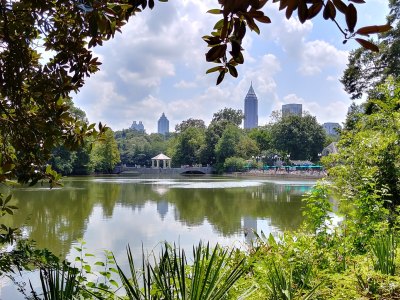
A view of Midtown over Lake Clara Meer in Piedmont Park. (Photo by Charity Davenport under CC0 1.0)
Situated between two of Atlanta’s most popular neighborhoods, Virginia-Highland and Midtown, this open space acts as the city’s “Central Park.” And like its northern sibling, Piedmont’s walking trails, meadows, swimming pools and gardens get congested. If you want to get away, head to the Northwoods to experience the park’s wilder side. This 53-acre expansion was added in 2011 and includes an unpaved segment of the BeltLine. You’ll also find dirt paths and boardwalks that lead into Piedmont’s Six Springs Wetlands and Walker Woods, allowing you to string together substantial hikes and runs through dense forests full of small creeks, ponds and wildlife without the substantial crowds.
2. Eastside Trail
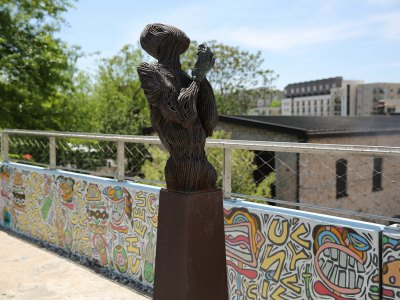
One of the many art installations along the BeltLine’s Eastside Trail. (Photo by Eddie Krebs under CC BY 2.0)
Atlanta doesn’t have as many parks as most other cities of its size. According to The Trust for Public Land’s ParkScore index, only 6 percent of the city is devoted to recreation, but Atlanta is working hard to fix that in a big way with the BeltLine. This 3-mile section from Monroe Drive to Kirkwood Avenue was the first part of the trail to open and has become a new kind of Main Street, with some businesses along it even listing their mile marker along the path in addition to a traditional street address. And don’t miss the trail’s vibrant art scene and events; the BeltLine has hosted an annual exhibition of sculptures, muralists and other artists for the past decade.
3. Westside Trail
While the 3-mile-long Eastside Trail has already become a hot spot of recreation and development, the newer Westside Trail offers just as much mileage with a fraction of the users. The path cruises by the BeltLine’s Urban Farm, the 20-acre Washington Park and plenty of new restaurants and bars, like Lean Draft House. Even better, it connects with existing spur trails, like the 2.5-mile West End Trail and the 1.15-mile Southwest Connector Spur Trail to easily extend your ride, run or walk away from the crowds.
4. Historic Fourth Ward Park
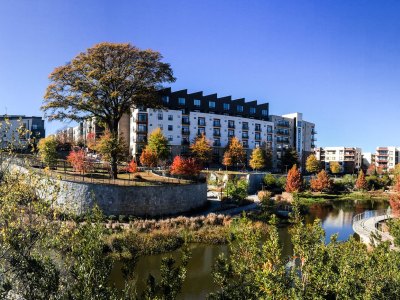
The Historic Fourth Ward Park was once a parking lot along the Eastside Trail. (Photo by Shawn Taylor under CC BY 2.0)
It wasn’t long ago that this 17-acre slice of the Old Fourth Ward neighborhood, the childhood home of Martin Luther King Jr., was a parking lot. Thankfully, the popularity of the BeltLine’s Eastside Trail, which runs through the park, spurred the city to transform the former concrete wasteland into a green space. “It has such an Atlanta vibe, with yoga and the BeltLine and great fried chicken nearby,” says Siha Collins, who teaches the park’s free and absolutely massive Sunday night yoga sessions hosted by local ice pop-makers King of Pops. Expansive lawns surround a world-class skate park and a man-made pond that was built as a rainwater management system. Wander the walking paths or picnic under the shade trees near the 10-foot-tall waterfall that aerates the pond. Then head over to nearby Ponce City Market for an après pint and a few pieces of that fried chicken.
5. East and West Palisades
This National Recreation Area northwest of downtown protects 48 miles of the city’s beloved Chattahoochee River from Buford Dam to Peachtree Creek. It also sees nearly 3 million visitors a year. Only a third of them actually get on the water to paddle or fish, says Jason Ulseth, the Chattahoochee River Keeper, so consider it a one-way ticket to solitude. Everyone has their favorite section, but the National Recreation Area’s East and West Palisades offer an easy escape close to the city, with hiking and biking trails covering both sides of the river. “It’s like you’re in a whole different world,” Ulseth says. “You don’t see buildings or cars—nothing but the river. It’s incredible that we have this resource where you can jump from the city and be in the wild almost immediately.” If you want to get out on the water, this 3-mile section of the “’Hooch” between the Powers Island and Pace Mill river access points has occasional Class I-II shoal, making it the ideal spot to practice swift-water skills. Need a refresher on paddling basics before you hit the water? No problem. Your local REI has a variety of paddling and kayaking classes to teach you the basics of taking to the water.
6. Fetch Park and Ice House
Happy hour is even happier with your furry best friend, so head to Fetch, a dog-friendly bar in Old Fourth Ward. Bartenders in an Airstream trailer whip up cocktails and sling local pints for thirsty humans while dogs play on the massive, artificial turf field (so there’s no mud). “It’s the perfect place to go after a hike to let your dog finish getting her energy out while you have a cocktail,” says Tucker Berta Sarkisian, an Atlanta resident that works for Sweetwater Brewing Company. There are even cooling stations—stainless steel tubs filled with water—so your pup can clean up after the trail. (A $10 daily membership fee gets you access to the party.) Keep an eye out for the addition of a shipping container-turned-restaurant set to open later this year.
7. Cabbagetown Street Art
With the likes of local graffiti superstar Greg Mike leading the charge to put the city’s vibrant street-art scene on the international map, you can head to nearly any corner of Atlanta and find a mural. Or you can head to east side’s Cabbagetown, arguably the best one-stop shop in the city for sampling the scene. The neighborhood’s Krog Street Tunnel, on the Eastside Trail between Dekalb Avenue and Wylie Street, houses an ever-changing collection of paintings. The wall that separates Wylie Street from the rail yard is covered in some of the city’s finest street art, thanks in large part to Forward Warrior, an annual event where the public can watch celebrated artists practice their craft.
8. Waterworks Greenspace
Residents spent more than two decades working to get the land surrounding Atlanta’s Waterworks facility reopened to the public after it was closed during the ’96 Olympics for security concerns. Last winter, visitors were finally welcomed into this 4.5-acre park. It’s a mellow space, full of picnic tables, shade trees and an incredible view of Midtown and Downtown Atlanta. Bring a Frisbee and hammock to sling from the permanent hammock stands.
9. Stone Mountain Trail
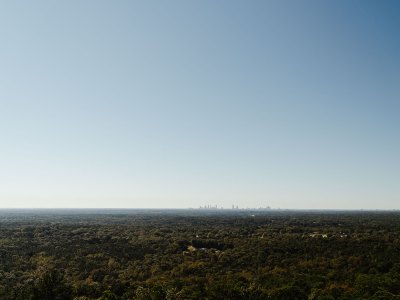
Atlanta’s Skyline juts from a canopy of trees as seen from Stone Mountain.
The BeltLine may get all the attention these days, but there’s another multiuse path in town that shouldn’t be missed. The Stone Mountain Trail runs for 19 miles from downtown’s Centennial Olympic Park to the trail’s namesake 825-foot-tall granite dome and 3,200-acre park. Serious cyclists can knock out the entire route plus a 5-mile loop around the monolith before heading back to town. Casual riders can stick to the in-town section, which connects Centennial Park with the Martin Luther King Jr. National Historical Park, the Fernbank Museum of Natural History and, well, the BeltLine near the Jimmy Carter Presidential Library and Museum.
10. The Roof at Ponce City Market
The transformation of this former Sears, Roebuck and Company building into a multistory retail, dining and office space is one of Old Fourth Ward’s biggest revitalization success stories. You’ll find trendy shops and some of the best food in the city on the main floor, where several renowned chefs have opened outposts in the casual food hall. Or take the freight elevator to the rooftop for the beer garden and cocktail parlor and Skyline Park, a carnival with games like Putt-Putt and Skee-Ball. Through August, it’s also home to a faux summer camp with camp-inspired food, cocktails and games. Of course, the biggest attraction might be the view, which looks over the city’s dense tree canopy toward the southern skyline all year long.
11. Fernbank Forest
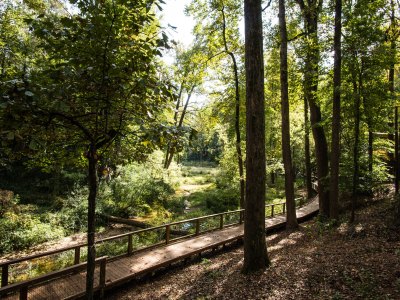
A boardwalk snakes through the trees at Fernbank Forest. (Photo by Shawn Taylor CC BY 2.0)
You could spend all day perusing the recreated dinosaur skeletons, fossils and rotating exhibits inside the Fernbank Museum of Natural History, but venture beyond its walls and you’ll find an ancient wilderness. The museum maintains more than 2 miles of trails for exploring its 65-acre, old-growth forest, the largest urban forest of its kind in the country. The trails can be steep at times, so they’re more of a hike than a stroll, and you’ll pass small creeks where amphibians laze and trees that reach 16 stories tall. Entrance to the forest is free with museum admission and so is Fernbank’s WildWoods, a neighboring system of elevated outdoor walkways, tree pods, art installations and interactive educational exhibits.
12. Cascade Springs Nature Preserve
There’s a lot of history inside this 120-acre green space. You can still see trenches dug by Civil War soldiers, and its springs were once considered to be restorative by Atlanta’s early residents. The water was even bottled and sold in the 1950s. Today, the forest boasts 3 miles of trails that spiderweb past challenging hills, a small waterfall and a unique art installation where the city also commissioned local artists to paint vibrant murals on the park’s benches and tables. “It’s probably my favorite green space inside the perimeter,” says Michelle Jackson-Saulters, cofounder of The Outdoor Journal Tour, which facilitates personal growth for women through the outdoors and exercise. “It’s such a great mix of wilderness and art from local artists.”
13. Southside Park
In 2016, the Atlanta chapter of the Southern Off-Road Bicycle Association leveraged grants from REI to help build a 1.25-mile beginner trail in Southside Park, a 211-acre green space a few miles east of the airport. It was the first legal mountain bike trail in an Atlanta city park, and it was recently joined by a new 3-mile intermediate loop. Both trails focus on flow, with berms and grade reversals that offer a roller-coaster ride ideal for those just learning the ropes or improving their skills. Not a cyclist? REI has beginner mountain bike classes to teach you the basics, and these paths are open to runners and hikers, too. And this is just the beginning, as 17 miles of trails are planned for the urban park.
14. Morningside Nature Preserve
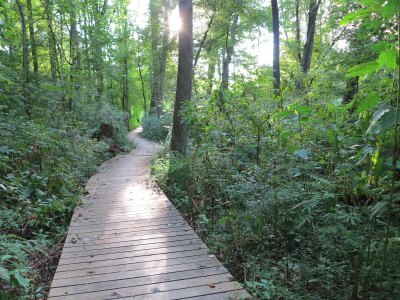
The sun peeks through a gap in the trees at Morningside Nature Preserve. (Photo by Jim Hodgson CC BY 2.0)
This park isn’t huge—just 33 acres—but it was singled out for preservation more than a decade ago by The Nature Conservancy, which found the quality and location of its mature forest to be key for the nearby Chattahoochee River’s water quality. There are around 2 miles of hiking trails, but the real highlight is the sandy beach beneath the wooden suspension bridge that traverses South Fork Peachtree Creek. “It’s a beautiful scene and a great place to run with dogs,” says Daniel Jessee, REI’s Regional Experiences Manager. “You feel like you’re in the middle of nowhere.”
15. Ladybird Grove and Mess Hall
You could argue that the best part of car camping is the food. Or the lawn games. Or the cooler of beer. Ladybird Grove and Mess Hall, in the city’s Old Fourth Ward neighborhood, combines all into a restaurant and bar focused on “elevated campfire fare.” Picture an adult summer camp that serves up dishes like Brunswick stew, pot-roast skillets and “picnic baskets” filled with assorted meats, cheeses, pickles and jams. Skip the indoor bar in favor of the outdoor beer garden, complete with camp chairs, cornhole boards and ping-pong tables. Order the Patio Punch, which is made with whatever fruit is ripe from the garden’s camper-turned-bar.
16. South Peachtree Creek Trail
A trek on this path is a great way to understand how Atlanta earned its nickname, “The City In the Forest.” For 3.5 miles, it travels through dense hardwood groves northeast of Midtown, often as an elevated boardwalk that puts you in the canopy itself. The Y-shaped trail also connects to several smaller parks and Emory University. Eventually, the trail will continue through the campus and connect with Freedom Park Trail and the BeltLine’s Eastside Trail. Until then, it’s still a perfect, shady retreat from the bustling city for walkers, runners and cyclists.
Get involved with REI classes and events at the Atlanta REI location. From cycling to paddling, we offer a variety of ways to help you get outdoors.
1. Piedmont Park

A view of Midtown over Lake Clara Meer in Piedmont Park. (Photo by Charity Davenport under CC0 1.0)
Situated between two of Atlanta’s most popular neighborhoods, Virginia-Highland and Midtown, this open space acts as the city’s “Central Park.” And like its northern sibling, Piedmont’s walking trails, meadows, swimming pools and gardens get congested. If you want to get away, head to the Northwoods to experience the park’s wilder side. This 53-acre expansion was added in 2011 and includes an unpaved segment of the BeltLine. You’ll also find dirt paths and boardwalks that lead into Piedmont’s Six Springs Wetlands and Walker Woods, allowing you to string together substantial hikes and runs through dense forests full of small creeks, ponds and wildlife without the substantial crowds.
2. Eastside Trail

One of the many art installations along the BeltLine’s Eastside Trail. (Photo by Eddie Krebs under CC BY 2.0)
Atlanta doesn’t have as many parks as most other cities of its size. According to The Trust for Public Land’s ParkScore index, only 6 percent of the city is devoted to recreation, but Atlanta is working hard to fix that in a big way with the BeltLine. This 3-mile section from Monroe Drive to Kirkwood Avenue was the first part of the trail to open and has become a new kind of Main Street, with some businesses along it even listing their mile marker along the path in addition to a traditional street address. And don’t miss the trail’s vibrant art scene and events; the BeltLine has hosted an annual exhibition of sculptures, muralists and other artists for the past decade.
3. Westside Trail
While the 3-mile-long Eastside Trail has already become a hot spot of recreation and development, the newer Westside Trail offers just as much mileage with a fraction of the users. The path cruises by the BeltLine’s Urban Farm, the 20-acre Washington Park and plenty of new restaurants and bars, like Lean Draft House. Even better, it connects with existing spur trails, like the 2.5-mile West End Trail and the 1.15-mile Southwest Connector Spur Trail to easily extend your ride, run or walk away from the crowds.
4. Historic Fourth Ward Park

The Historic Fourth Ward Park was once a parking lot along the Eastside Trail. (Photo by Shawn Taylor under CC BY 2.0)
It wasn’t long ago that this 17-acre slice of the Old Fourth Ward neighborhood, the childhood home of Martin Luther King Jr., was a parking lot. Thankfully, the popularity of the BeltLine’s Eastside Trail, which runs through the park, spurred the city to transform the former concrete wasteland into a green space. “It has such an Atlanta vibe, with yoga and the BeltLine and great fried chicken nearby,” says Siha Collins, who teaches the park’s free and absolutely massive Sunday night yoga sessions hosted by local ice pop-makers King of Pops. Expansive lawns surround a world-class skate park and a man-made pond that was built as a rainwater management system. Wander the walking paths or picnic under the shade trees near the 10-foot-tall waterfall that aerates the pond. Then head over to nearby Ponce City Market for an après pint and a few pieces of that fried chicken.
5. East and West Palisades
This National Recreation Area northwest of downtown protects 48 miles of the city’s beloved Chattahoochee River from Buford Dam to Peachtree Creek. It also sees nearly 3 million visitors a year. Only a third of them actually get on the water to paddle or fish, says Jason Ulseth, the Chattahoochee River Keeper, so consider it a one-way ticket to solitude. Everyone has their favorite section, but the National Recreation Area’s East and West Palisades offer an easy escape close to the city, with hiking and biking trails covering both sides of the river. “It’s like you’re in a whole different world,” Ulseth says. “You don’t see buildings or cars—nothing but the river. It’s incredible that we have this resource where you can jump from the city and be in the wild almost immediately.” If you want to get out on the water, this 3-mile section of the “’Hooch” between the Powers Island and Pace Mill river access points has occasional Class I-II shoal, making it the ideal spot to practice swift-water skills. Need a refresher on paddling basics before you hit the water? No problem. Your local REI has a variety of paddling and kayaking classes to teach you the basics of taking to the water.
6. Fetch Park and Ice House
Happy hour is even happier with your furry best friend, so head to Fetch, a dog-friendly bar in Old Fourth Ward. Bartenders in an Airstream trailer whip up cocktails and sling local pints for thirsty humans while dogs play on the massive, artificial turf field (so there’s no mud). “It’s the perfect place to go after a hike to let your dog finish getting her energy out while you have a cocktail,” says Tucker Berta Sarkisian, an Atlanta resident that works for Sweetwater Brewing Company. There are even cooling stations—stainless steel tubs filled with water—so your pup can clean up after the trail. (A $10 daily membership fee gets you access to the party.) Keep an eye out for the addition of a shipping container-turned-restaurant set to open later this year.
7. Cabbagetown Street Art
With the likes of local graffiti superstar Greg Mike leading the charge to put the city’s vibrant street-art scene on the international map, you can head to nearly any corner of Atlanta and find a mural. Or you can head to east side’s Cabbagetown, arguably the best one-stop shop in the city for sampling the scene. The neighborhood’s Krog Street Tunnel, on the Eastside Trail between Dekalb Avenue and Wylie Street, houses an ever-changing collection of paintings. The wall that separates Wylie Street from the rail yard is covered in some of the city’s finest street art, thanks in large part to Forward Warrior, an annual event where the public can watch celebrated artists practice their craft.
8. Waterworks Greenspace
Residents spent more than two decades working to get the land surrounding Atlanta’s Waterworks facility reopened to the public after it was closed during the ’96 Olympics for security concerns. Last winter, visitors were finally welcomed into this 4.5-acre park. It’s a mellow space, full of picnic tables, shade trees and an incredible view of Midtown and Downtown Atlanta. Bring a Frisbee and hammock to sling from the permanent hammock stands.
9. Stone Mountain Trail

Atlanta’s Skyline juts from a canopy of trees as seen from Stone Mountain.
The BeltLine may get all the attention these days, but there’s another multiuse path in town that shouldn’t be missed. The Stone Mountain Trail runs for 19 miles from downtown’s Centennial Olympic Park to the trail’s namesake 825-foot-tall granite dome and 3,200-acre park. Serious cyclists can knock out the entire route plus a 5-mile loop around the monolith before heading back to town. Casual riders can stick to the in-town section, which connects Centennial Park with the Martin Luther King Jr. National Historical Park, the Fernbank Museum of Natural History and, well, the BeltLine near the Jimmy Carter Presidential Library and Museum.
10. The Roof at Ponce City Market
The transformation of this former Sears, Roebuck and Company building into a multistory retail, dining and office space is one of Old Fourth Ward’s biggest revitalization success stories. You’ll find trendy shops and some of the best food in the city on the main floor, where several renowned chefs have opened outposts in the casual food hall. Or take the freight elevator to the rooftop for the beer garden and cocktail parlor and Skyline Park, a carnival with games like Putt-Putt and Skee-Ball. Through August, it’s also home to a faux summer camp with camp-inspired food, cocktails and games. Of course, the biggest attraction might be the view, which looks over the city’s dense tree canopy toward the southern skyline all year long.
11. Fernbank Forest

A boardwalk snakes through the trees at Fernbank Forest. (Photo by Shawn Taylor CC BY 2.0)
You could spend all day perusing the recreated dinosaur skeletons, fossils and rotating exhibits inside the Fernbank Museum of Natural History, but venture beyond its walls and you’ll find an ancient wilderness. The museum maintains more than 2 miles of trails for exploring its 65-acre, old-growth forest, the largest urban forest of its kind in the country. The trails can be steep at times, so they’re more of a hike than a stroll, and you’ll pass small creeks where amphibians laze and trees that reach 16 stories tall. Entrance to the forest is free with museum admission and so is Fernbank’s WildWoods, a neighboring system of elevated outdoor walkways, tree pods, art installations and interactive educational exhibits.
12. Cascade Springs Nature Preserve
There’s a lot of history inside this 120-acre green space. You can still see trenches dug by Civil War soldiers, and its springs were once considered to be restorative by Atlanta’s early residents. The water was even bottled and sold in the 1950s. Today, the forest boasts 3 miles of trails that spiderweb past challenging hills, a small waterfall and a unique art installation where the city also commissioned local artists to paint vibrant murals on the park’s benches and tables. “It’s probably my favorite green space inside the perimeter,” says Michelle Jackson-Saulters, cofounder of The Outdoor Journal Tour, which facilitates personal growth for women through the outdoors and exercise. “It’s such a great mix of wilderness and art from local artists.”
13. Southside Park
In 2016, the Atlanta chapter of the Southern Off-Road Bicycle Association leveraged grants from REI to help build a 1.25-mile beginner trail in Southside Park, a 211-acre green space a few miles east of the airport. It was the first legal mountain bike trail in an Atlanta city park, and it was recently joined by a new 3-mile intermediate loop. Both trails focus on flow, with berms and grade reversals that offer a roller-coaster ride ideal for those just learning the ropes or improving their skills. Not a cyclist? REI has beginner mountain bike classes to teach you the basics, and these paths are open to runners and hikers, too. And this is just the beginning, as 17 miles of trails are planned for the urban park.
14. Morningside Nature Preserve

The sun peeks through a gap in the trees at Morningside Nature Preserve. (Photo by Jim Hodgson CC BY 2.0)
This park isn’t huge—just 33 acres—but it was singled out for preservation more than a decade ago by The Nature Conservancy, which found the quality and location of its mature forest to be key for the nearby Chattahoochee River’s water quality. There are around 2 miles of hiking trails, but the real highlight is the sandy beach beneath the wooden suspension bridge that traverses South Fork Peachtree Creek. “It’s a beautiful scene and a great place to run with dogs,” says Daniel Jessee, REI’s Regional Experiences Manager. “You feel like you’re in the middle of nowhere.”
15. Ladybird Grove and Mess Hall
You could argue that the best part of car camping is the food. Or the lawn games. Or the cooler of beer. Ladybird Grove and Mess Hall, in the city’s Old Fourth Ward neighborhood, combines all into a restaurant and bar focused on “elevated campfire fare.” Picture an adult summer camp that serves up dishes like Brunswick stew, pot-roast skillets and “picnic baskets” filled with assorted meats, cheeses, pickles and jams. Skip the indoor bar in favor of the outdoor beer garden, complete with camp chairs, cornhole boards and ping-pong tables. Order the Patio Punch, which is made with whatever fruit is ripe from the garden’s camper-turned-bar.
16. South Peachtree Creek Trail
A trek on this path is a great way to understand how Atlanta earned its nickname, “The City In the Forest.” For 3.5 miles, it travels through dense hardwood groves northeast of Midtown, often as an elevated boardwalk that puts you in the canopy itself. The Y-shaped trail also connects to several smaller parks and Emory University. Eventually, the trail will continue through the campus and connect with Freedom Park Trail and the BeltLine’s Eastside Trail. Until then, it’s still a perfect, shady retreat from the bustling city for walkers, runners and cyclists.
Get involved with REI classes and events at the Atlanta REI location. From cycling to paddling, we offer a variety of ways to help you get outdoors.